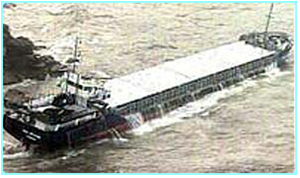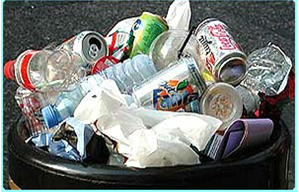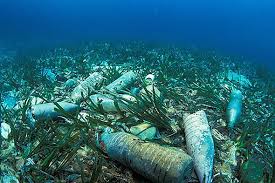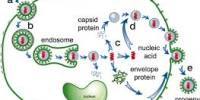Introduction
Environmental pollution is a multi-disciplinary science involving chemistry, physics, life science, agriculture, medical science, public health, sanitary engineering etc. In broader sense, it is the study of the sources, reactions, transport, effect and fate of chemical species in the air, water and soil and the effect of human activity upon these.
Pollutant: A substance present in nature, in greater than natural abundance due to human activity, which ultimately has a detrimental effect on the environment and therefrom on living organisms and mankind. Examples are- lead, mercury, sulphur dioxide, carbon monoxide, etc.
Contaminant: A material which does not occur in nature, but is introduced by human activity into the environment, affecting its composition. A contaminant is classified as a pollutant when it exerts a detrimental effect. Example- chlorine gas
Types of Pollution
Air
Causes of air pollution:
- motor vehicle exhaust
- power stations
- car manufacturing
- fertilizer factories
- demolishing buildings
- solvent evaporation
- volcanic eruption
- building roads
- forest fires
Effect of air pollution:
Global warming, acid rain, smog, ozone depletion are some effects of air pollution

Water
Causes of water pollution:
- man-made chemicals used in farming
- heavy metals
- waste from factories
- sediment from the river bed
- air pollution
- thermal (heat) pollution
- soil pollution from rubbish dumps
Effects of water pollution:
The water in the earth’s biosphere is used and reused again and again by all living things

Soil
Causes of soil pollution:
- farming
- mining and quarrying
- household waste
- demolition and putting up buildings
- factory waste
Effects of soil pollution:
Experts say that lots of land each year becomes unusable for humans or animals.

Noise
Causes of noise pollution:
- noisy roads and traffic
- air traffic
- rail traffic
- household noise
- industrial noise
Effects of noise pollution:
We hear and make sounds nearly all the time but too much noise can make us feel angry or depressed. The time of day that noises are heard is very important.

Radiation
Pollution from radiation can be caused by:
- nuclear power plants
- making nuclear weapons
- disposal of nuclear waste
- mining for uranium

What can happen?
Radiation occurs naturally at low levels and is a useful source of power when concentrated.
It can also be very harmful to all living things if they are exposed to too much of it.
Light
Light pollution happens when outside lights, such as a streetlight or a security light, points light upwards into the night sky.
This light gets scattered in the sky and makes an orange foggy glow to appear above a town.
What can happen?
It is likely that we won’t be able to see the stars in the night sky if the amount of light pollution isn’t closely controlled.

CONSERVATION AND ENVIRONMENT MANAGEMENT
It is imperative that we carefully utilise our renewable resources of soil, water, plant and animal life to sustain our economic development. Over exploitation of these is reflected in soil erosion, siltation, floods, and rapid destruction of our forest, floral and wildlife resources. The depletion of these resources often tends to be irreversible and since the bulk of our population depends on these natural resources to meet the basic needs, it has meant a deterioration in their quality of life.
Global petroleum deposits are likely to be exhausted within this century. Research is going on for alternatives to fossil fuel (petroleum) based on biomass (green energy). Controlled nuclear fusion holds the prospect of abundant energyif the relatively difficult deuterium-deuterium fusion reaction can be utilised for energy production. This energy source will become unlimited.
Solar energy is both renewable and non-polluting and provides ideal energy source. On a global scale, tapping of only a small fraction of solar energy the earth can supply the entire energy requirement.
In any new development project, due consideration must be given to the environmental, social and cultural impacts. For this purpose, environmental experts must be involved in project planning.
DISASTERS
NATURAL AND MANMADE DISASTERS
Sometimes there are drastic changes in environment due to natural disasters, e.g. cyclone, typhoon, hurricane, tornado, earthquake, volcanic eruption etc. within a short time.
Bush fires, are another type of natural disasters, are of common occurrence in some regions of the world due to hot summer and lightning. During the hot summer months bush fires are common in Australia and in the Pacific coast arid areas in USA.
Man developed science and technology but over the years since the Industrial Revolution (1780- todate) he continued to plunder natural resources thereby polluting the environment. He degraded lands, destroyed forests, threw toxic wastes into rivers and seas and also harmful gases into the atmosphere. This continuous load of manmade pollutants into environment brought about adverse changes, which ultimately back-fired into series of disasters from time to time.
Some examples of manmade disasters are: London smog, Minamata disease, nuclear explosions, Bhopal disaster, Chernobyl disaster and Gulf War Hazards.
Nuclear Explosions. Two bombs were dropped by USA during World War II (Aug 6 and 9, 1945) on Hiroshima and Nagasaki in Japan. These instantly killed about 6 lakhs people, wiped out the two cities and unleashed radioactive fallout which has caused generations to suffer from various diseases including genetic disorder. Radiation continues to damage plants, soil and biosphere* in the region.
*the environment consists of four segments- atmosphere, hydrosphere, lithosphere and bioshphere.
Global Warming or Green House Effect
Among the constituents of the atmosphere, only carbon dioxide and water vapour strongly absorb infrared radiation (14000 to 25000 nm) and effectively block a large fraction of the earth’s emitted radiation. The radiation thus absorbed by carbon dioxide and water vapour is partly re-emitted to the earth’s surface. The net result is that the earth’s surface gets heated up by a phenomenon called the greenhouse effect.
The current global trend in deforestation along with increased combustion of fossil fuels have a cumulative effect on the net increase in carbon dioxide content (present 356 ppm, 50%). Carbon dioxide has the potential to rival nuclear wars in terms of massive irreversible damage to the environment. It is the major greenhouse gas but there are other greenhouse gases- methane (CH4, 19%), chlorofluorocarbons (CFC, 17%), nitrous oxide (N2O, 4%) and water vapour (2%).
Ozone Hole
In september, 1980 scientists reported a large hole in the ozone layer over Antarctica. CFC was the prime suspect for causing ozone depletion. It was established that one molecule of CFC is capable of destroying one lakh O3 molecule in the stratosphere. The extreme chemical stability and nontoxicity of CFCs enable them to persist for years in the atmosphere and to enter the stratosphere. Depletion of ozone layer above the earth surface helps to penetrate harmful rays from the sun to the earth.
















